A Nothing to Do with C&Sng Request for Information
A Nothing to Do with C&Sng Request for Information
|
This post was updated on .
No C&S content here, feel free to click the back button.
The other night I was bored while on-call in the hospital and began surfing the web. I stumbled on this map, dated 1882: 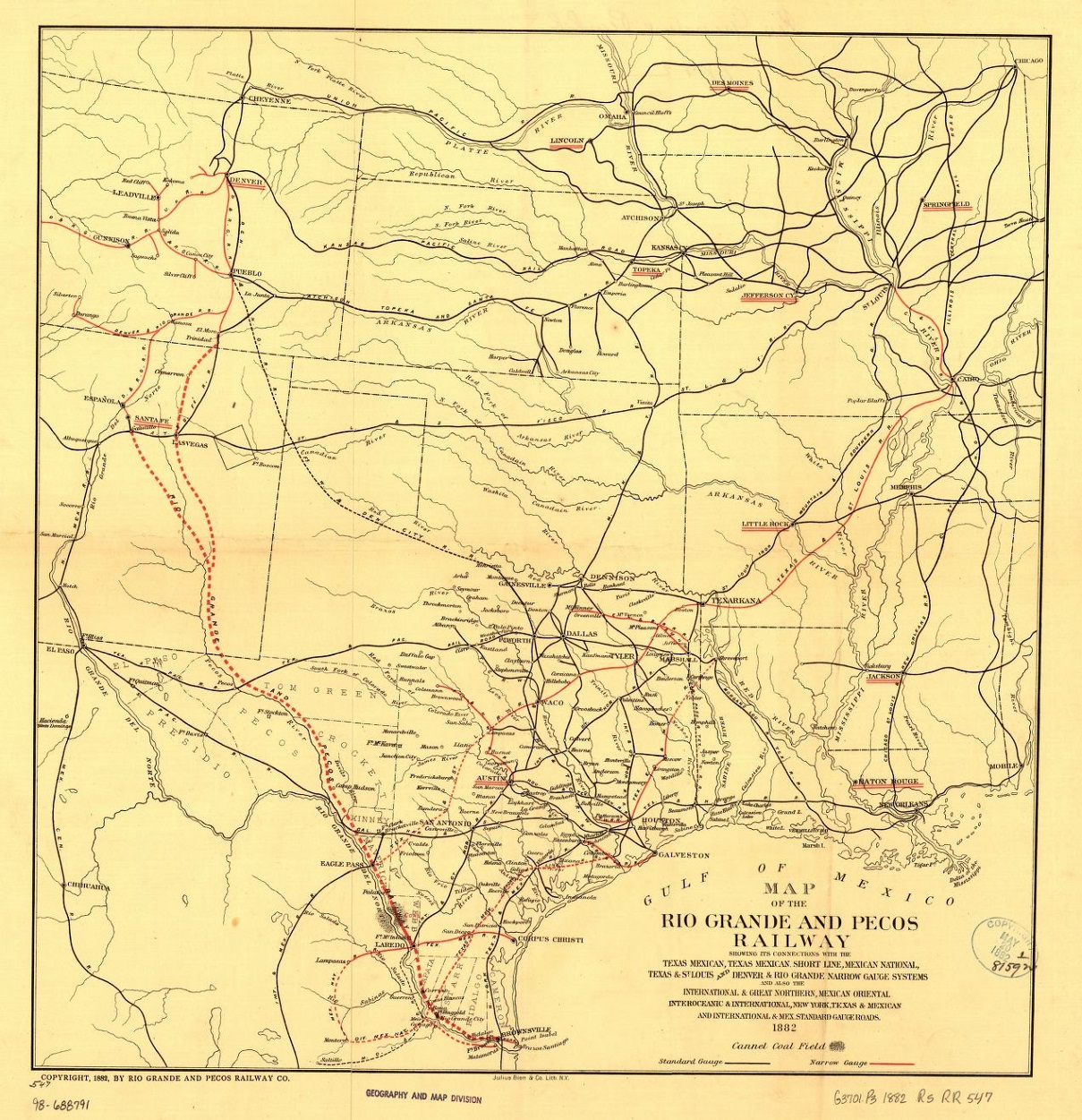 The map was drawn to show the proposed route of a new narrow gauge railroad, the "Rio Grande and Pecos Rwy". You will recall that General Palmer's original aim was to construct the D&RG south from Denver to El Paso, Texas, with no intention of building west into the mountains. But the Santa Fe took Raton Pass away from him, and Jay Gould's mediation of the Tripartite agreement stopped him at Trinidad and Espanola. This map shows an outlandish proposed line to connect the 3' gauge D&RG (at either Trinidad or Santa Fe, or both) with Brownsville, Texas on the Gulf of Mexico, via the Pecos and Rio Grande river drainage. Of course it was never built. What is interesting is the depiction of the narrow gauge common carriers in existence at that date, all shown in red. Check out Colorado in the upper left hand corner. The UP had leased the Colorado Central and acquired controlling interest in the DSP&P. Both are shown as UP lines. The South Park has reached Leadville via Buena Vista, but the Boreas Pass line and the Gunnison extension are still in the future. General Palmer, thwarted in his dream of building to Mexico, has completed the D&RG's transcontinental narrow gauge mainline via Gunnison, has built into Leadville and beyond to Kokomo and Red Cliff. The San Juan extension to Durango and Silverton have been completed. But look at the right hand half of the map. Look at that spider web of narrow gauge track in the East Texas piney woods. The Tyler Tap Railroad, building from Tyler to Texarkana, has acquired outside financing and has collaborated to complete a 3' gauge mainline all the way from St Louis, thru Arkansas and on into Central Texas to the city of Waco on the Brazos (near Dubya's future ranch site). This was at the height of the narrow gauge building frenzy and this incredible narrow gauge trunk line would be standard gauged before 1890 and become the basis for the Cotton Belt. And the Houston East and West Texas RR has been abuilding a 3' gauge line from Houston to Shreveport. From the capitol in Austin, the Austin and Northwestern is building into the Texas Hill Country; both these lines would be absorbed by the Southern Pacific. And in the north, the East Line and Red River Ry has constructed a 3' gauge line from Marshall west to Greenville, (north of Dallas); this line would later be acquired and operated by the Katy as a narrow gauge branch, before eventually standard gauged. My point is that the narrow gauge rail network of East and Central Texas in the early 1880s far surpassed in mileage the Colorado narrow gauges combined. But since there weren't rushing rivers in steep canons and narrow gauge tracks climbing mountain passes on spectacular trestles, the best photographers of the day never turned their cameras on them. The Texas narrow gauges just weren't sexy enough. They were gone (standard gauged) by the early 1890s, before popular, amateur photography arrived. I've only found a couple of images of Texas & St Louis equipment:   A subsidiary of the T&StL, the Kansas and Gulf Short Line RR Co., in 1880 started building to the southeast of Tyler from the T&StL mainline, aiming for the Gulf of Mexico at Sabine Pass. Their number 4, built by Cooke in 1883, looks strangely familiar: 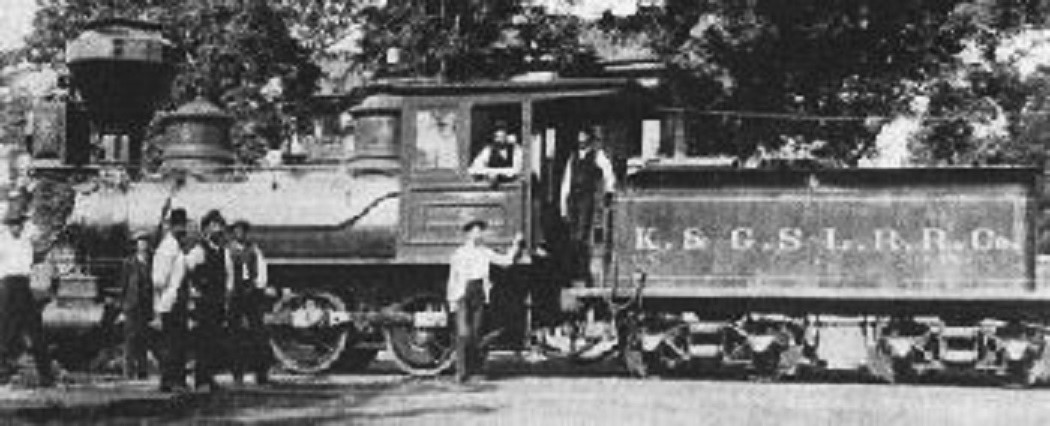 In Austin, A&NW No 5, the only 2-8-0 on the roster, had its photo taken shortly after delivery from Mount Savage. It was equivalent in size to a class 56 D&RG engine or a Baldwin 2-8-0 on the South Park: 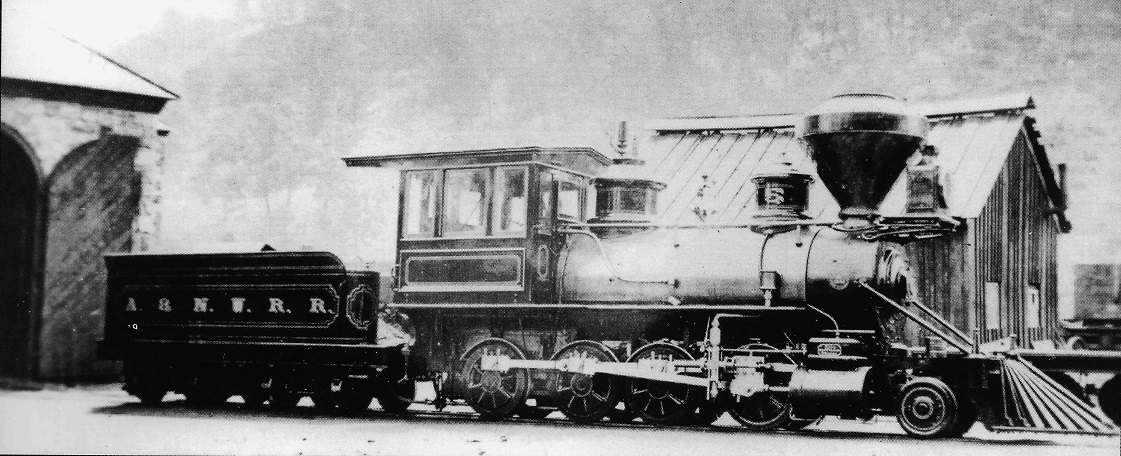 Austin History Center, Austin Public Library Since I have an interest in the early Texas narrow gauge lines, if you have any photos or information on these overlooked beauties of early narrow gauge railroading, please share them here. Thanks, now back to the C&S . . .
Jim Courtney
Poulsbo, WA |
Re: A Nothing to Do with C&Sng Request for Photos
|
Vague memories because I sold the book several years back-I believe Rails West and I believe it was by George Abdill had several Texas&St.Louis photos and the photo of the Cooke Mogul.Notice the A&NW engine has a crosshead pump.I first heard of A&NW when John Droste was posting material about Houston& Texas Central(which at one time was "state gauge"-5'6")The A&NW was later absorbed by the H&TC.
|
Re: A Nothing to Do with C&Sng Request for Photos
|
Thanks, Robert. I just ordered a used copy on Amazon.
Jim
Jim Courtney
Poulsbo, WA |
Re: A Nothing to Do with C&Sng Request for Photos
|
I'm not sure that that's the right one of his books.
|
Re: A Nothing to Do with C&Sng Request for Photos
|
What Could Have Been!
Rails West it is. The narrow gauge railroad that ran south from St. Louis was the Cairo and St. Louis. It was located in Missouri and ran from East St. Louis to Cairo. I believe they were talking of building or might have built a ferry system to shuttle cars across the Missouri to connect with the Texas & St. Louis near Cairo. I do know that the C&StL rented at least one of their locomotives to the T&StL At the same time the Toledo, Cincinnati & St. Louis was built west from Toledo, Ohio, across Indiana and Illinois to a connection with the Cairo & St. Louis at East St. Louis. I believe that they might have gotten a couple of trains thru to St. Louis before the whole thing collapsed. Think of it a 3' mainline from Lake Erie to almost the Gulf of Mexico Photos: Google "Jackson and Sharp Collection - Delaware Heritage Collection" Then enter in the search box "Houston East and West Texas" for a couple of passenger cars. Also one other thought the Litchfield car works at the time they were building cars for the DSP&P they were also building cars for the Tyler Tap, Houston East and West Texas, and the Texas & Saint Louis |
Re: A Nothing to Do with C&Sng Request for Photos
|
This post was updated on .
Thanks for these leads, Ron.
I've also learned from a thread on the NGRDF, that when Grant couldn't get the money-strapped D&RG to pay for an 1882 order for ten additional class 60 2-8-0s, they ended up selling the locomotives to various 3' gauge roads. At least two of these Grant 2-8-0s went to the Texas and St Louis. (http://ngdiscussion.net/phorum/read.php?1,305304,305358#msg-305358) Jim
Jim Courtney
Poulsbo, WA |
Re: A Nothing to Do with C&Sng Request for Photos
|
Remember that DSP&P Dawson&Baily Moguls 17-18-19 were from the Cairo(thats Kay-ro)&St.Louis.Wish there were more pictures of them-especially ones on the C&ST.L
|
Re: A Nothing to Do with C&Sng Request for Photos
|
In reply to this post by Ron Rudnick
Wow, thanks for the links Ron!
The Jackson and Sharp photos are great: http://delaware.contentdm.oclc.org/cdm/fullbrowser/collection/p15323coll6/id/1411/rv/singleitem/rec/3 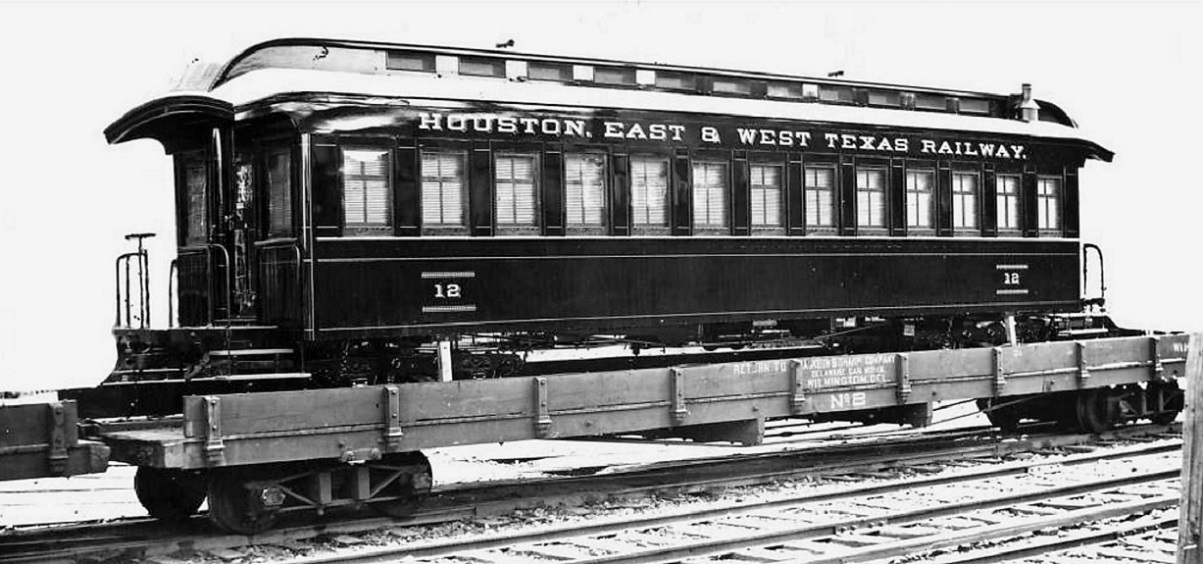 Are those Venetian blinds? http://delaware.contentdm.oclc.org/cdm/fullbrowser/collection/p15323coll6/id/2498/rv/singleitem/rec/1 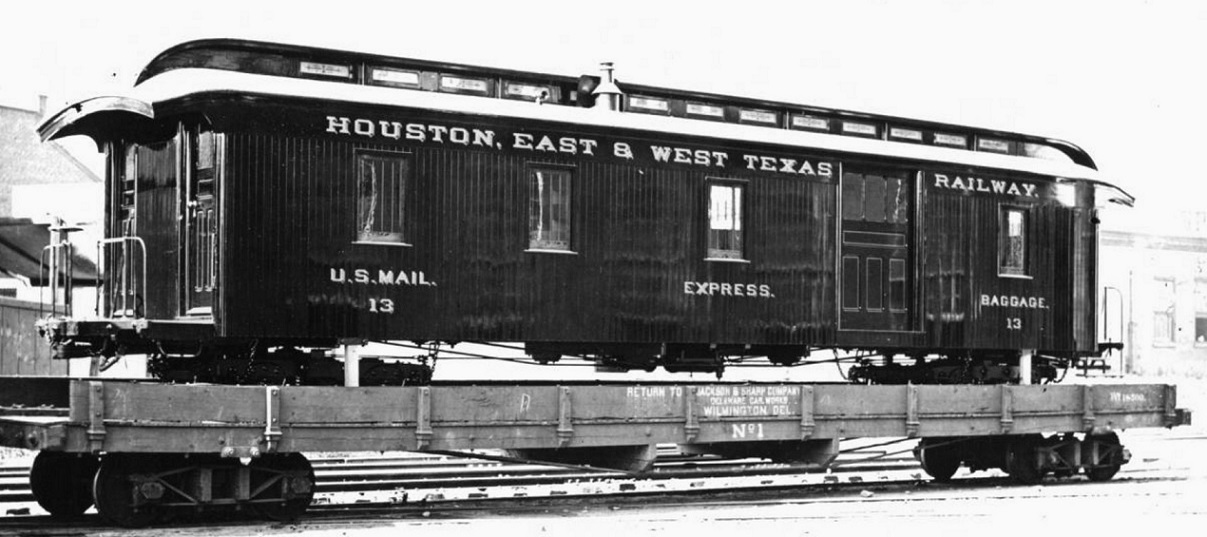 Has anyone ever seen a narrow gauge mail-express with two doors on the end? One to enter the mail compartment, the other to walk through the car to the baggage compartment and other end? I also learned from the NGR discussion forum, that the Texas & St Louis ran narrow gauge Pullman sleepers, built to the same plan as the "Toltec" on the D&RG: http://ngdiscussion.net/phorum/read.php?1,302662,302662#msg-302662 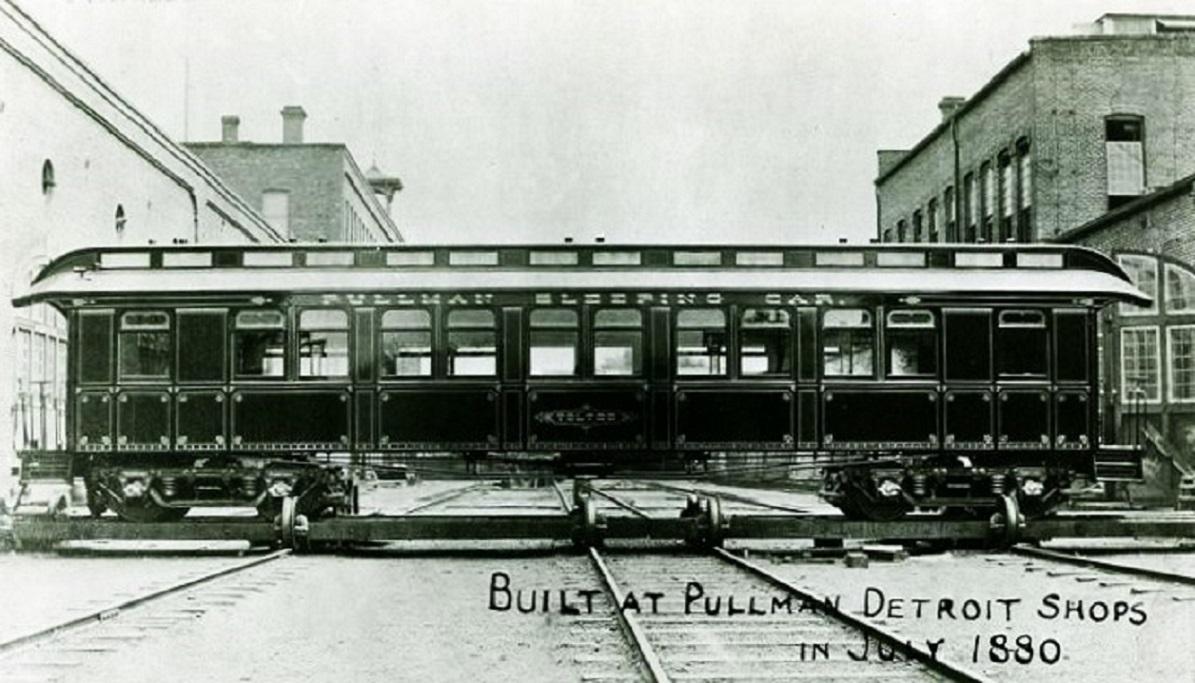 As to Litchfield building cars for the Texas & St Louis, can we assume they would have featured the same strap bolsters as on the DSP&P cars? Is there any source or records that list all the freight cars built by Litchfield for the various railroads? The only photo I've found to date of Texas narrow gauge freight cars, is this one of Austin & Northwestern number 5, switching cars in the East Austin yards: 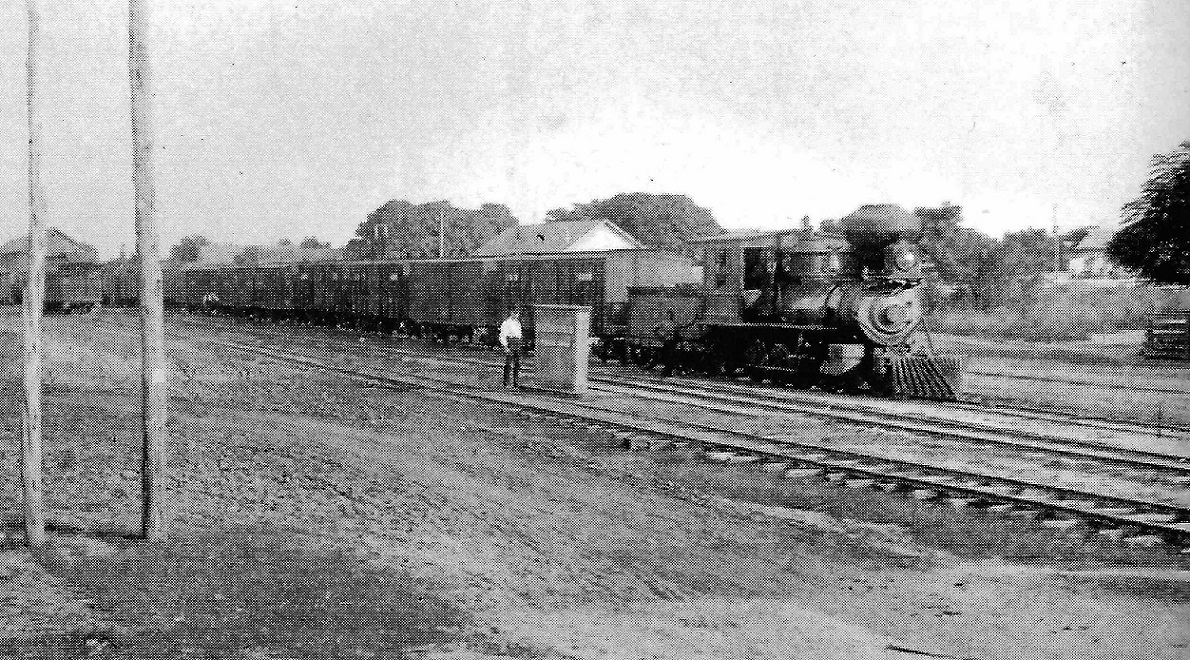 Austin History Center, Austin Public Library Several of the boxcars appear to be single sheathed, outside braced -- likely built on flat car bodies.
Jim Courtney
Poulsbo, WA |
Re: A Nothing to Do with C&Sng Request for Photos
|
This post was updated on .
In reply to this post by Robert McFarland
Speaking of Dawson-Bailey, the East Line & Red River's 155 mile narrow gauge line in far Northeast Texas had roster of 11 locomotives. The narrow gauge line was acquired by the MKT (actually, "dumped" on the Katy by Jay Gould) and operated as a narrow gauge division of the Katy from 1881 until standard gauged in 1893.
At least one of the locomotives was a Dawson & Bailey 4-6-0 of 1876, numbered 190 on the EL&RR, renumbered 404 by the Katy:  Fred Lyon collection, in Collias and George, Katy Power, page 19. The MKT caboose is likely a standard gauge car on narrow gauge trucks. Too bad the Katy's narrow gauge division didn't survive--can you imagine "Sloan Yellow" Katy narrow gauge boxcars??
Jim Courtney
Poulsbo, WA |
|
This post was updated on .
In reply to this post by Ron Rudnick
No luck yet on further information about Litchfield freight cars on the Texas narrow gauge lines.
But I did discover where all those 26-foot South Park freight cars were born: http://collections.carli.illinois.edu/cdm/fullbrowser/collection/sic_litchf/id/36/rv/singleitem/rec/11 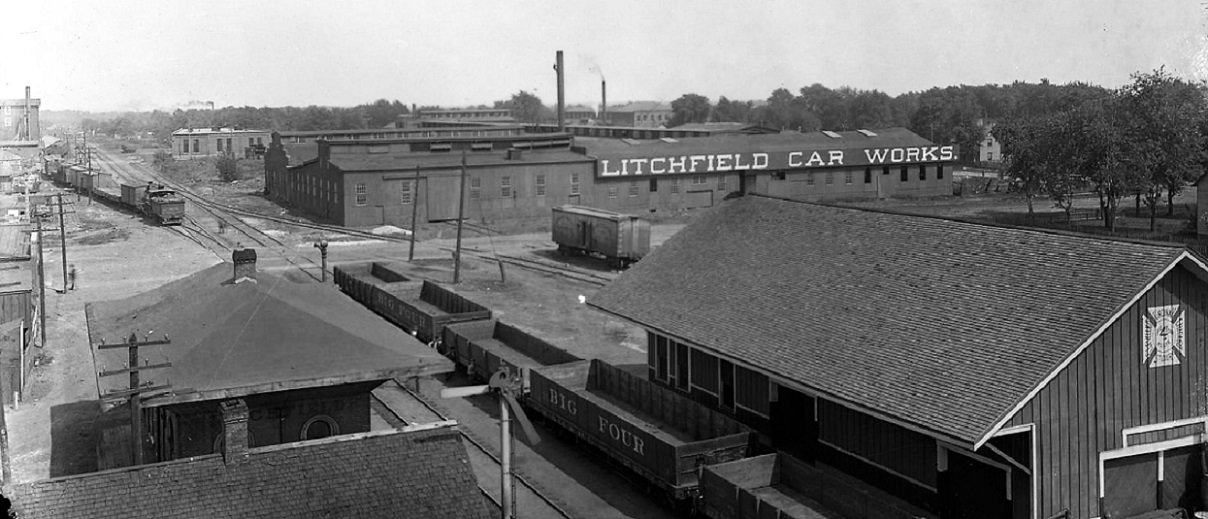
Jim Courtney
Poulsbo, WA |
|
Jim
I do not know of a builders list for the Litchfield Car Works I have a couple of pages of notes that I have found in reading old newspapers and the railroad trade journals ala Railroad Gazette The few notes I have are terribly incomplete, the closest they come to mentioning the DSP&P order is a note from the March, 1879 National Car Builder which reported they were building 25 box and 25 flat cars for a narrow gauge in Colorado. And later in November 1879 the Railway World reported they were building many cars for the DSP&P, HE&WT, the T&StL and for the Desloge Lead Company And lest we forget they also built 20 coal dump cars for the Colorado Central. And the only reason we know of this is from a Union Pacific Journal entry, as the is no mention of this by the press. IIRC I tried to locate microfilm of newspapers from the around Litchfield many years back with no luck. One last tidbit comes from the St. Louis Republican Oct 21. 1879: Freight cars for the new road running from Texarkana to Waco, TX are being forwarded by the St. Louis & Iron Mountain "they are labeled Texas and St. Louis" which maybe hints the railroad name was spelled out |
|
Thanks for the insights, Ron.
I've come upon a few other leads: Ed Gebhart published plans in The Gazette for a T&StL 2-6-0 back in the early 1990s, one of an order of 10 engines built by Grant. Evidently, flat land narrow gauge, not constrained by the sharp curvatures of mountain lines, had fairly long driver wheel bases for the day. The book "Cotton Belt Locomotives" supposedly has a complete roster of T&StL locomotives, not sure about rolling stock. A used copy is on its way from Amazon, along with Abdill's book. The University of Texas library has a complete, online collection of Sanborn insurance maps dating to 1885, for the major Texas towns served by the narrow gauge lines. Some of the maps are fascinating, including depots, turntables and crossings at grade with both standard and narrow gauge lines. I keep hoping that there will be an intersection of the Texas lines with the Colorado roads, at least after standard gauging moved surplus 3 foot equipment out of state. So far, Robert's mention of the C&StL 2-6-0s that went to the South Park are the only connection that I've found. Perhaps flat land narrow gauge equipment wasn't suited to the Mountain West. In reading about the Narrow Gauge building frenzy that swept the country from 1875 to 1890, it seems more and more like a classic economic "bubble", like the Dutch tulip bulb mania and the dot-com bubble of the late 1990s. The Panic of 1873 was a major recession that left economic scars on the country for a decade. As railroad building and an operations were the "high-tech" industry of the day, the premise of building new routes to new communities while limiting both capital expenditure and risk, by using narrow gauge, made some kinda sense given the context of recent, severe recession. It probably seemed like a winning idea at the time, the next great thing for the future. Who knew that American narrow gauge railroading would be the eight-track tape system of the age, falling into disfavor in only 10-15 years. The only reason our beloved Colorado lines survived well into the 20th century was that there was enough traffic to warrant continued operation, but not enough traffic to justify the capital expenditure of standard gauging those routes.
Jim Courtney
Poulsbo, WA |
|
Hilton's NG book is an awesome eye opener regarding just how popular
the NG idea was before 1890. It is amazing how much of it was built and how close the builders came to a nationally connected network.
"Duty above all else except Honor"
|
A Photo Book Report: Texas & St. Louis Narrow Gauge Equipment
|
This post was updated on .
In reply to this post by Ron Rudnick
Again, no C&S narrow gauge content here . . . nope, nada.
The leads that Robert McFarland and Ron Rudnick gave me, plus a reference by Ed Gebhart on a set of plans he drew back in the Sept/Oct 1984 issue of The Gazette, led me to buy two out of print books on Amazon: Abdill, George B., Rails West, Superior Publishing, Seattle WA, 1960. Strapac, Joseph A., Cotton Belt Locomotives, Shade Tree Books, Huntington Beach CA, 1977. The two books arrived on July 5th, and I have been amazed at the sheer number of high quality images of early T&StL narrow gauge equipment in both books, many more than I ever expected to find. I've tried to make the best high-resolution digital copies that I could for my own collection of early Texas narrow gauge railroading. Before the books arrived, searching on-line, I found only three low resolution images of this fascinating narrow gauge trunk line, posted in the opening thread above. Since the two books that provided this source material are long out of print, and were published 40 to 55 years ago, I thought there might be merit in sharing them with others on-line. I hope Darel will humor me if I post them here. If he (or others) feel the material is inappropriate for a C&S themed site, I will gladly take them down (but be sure to make copiers if you find them interesting). As always, I will try to credit the photographer if known, the collection in which the image resides and the source book and page number where the image was published. Texas & St Louis narrow gauge equipment: In the early years of the building of The Tyler Tap, and its immediate successor the Texas & St Louis, the railroad purchased the first seven locomotive from a smattering of small builders, much like other narrow gauge projects of the 1870s. Texas & St Louis number 1 was built by Dawson and Bailey in early 1877. No photos exist, but this illustration is based on similar D&B locomotives of the age: 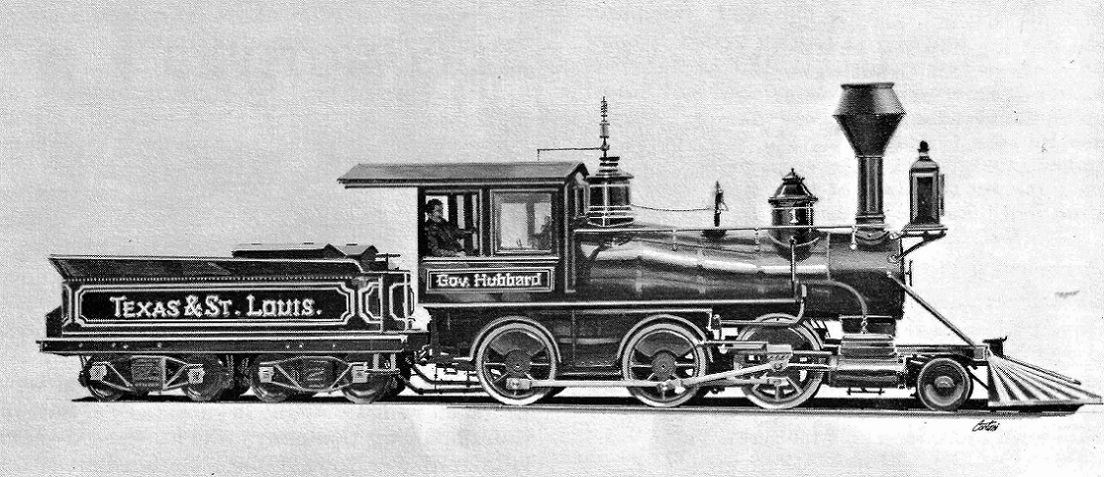 Drawing by Roger Cortani, in Strapac, Cotton Belt Locomotives, page30. Brooks built T&StL numbers 3 though 5 between the summer of 1879 and February 1880: 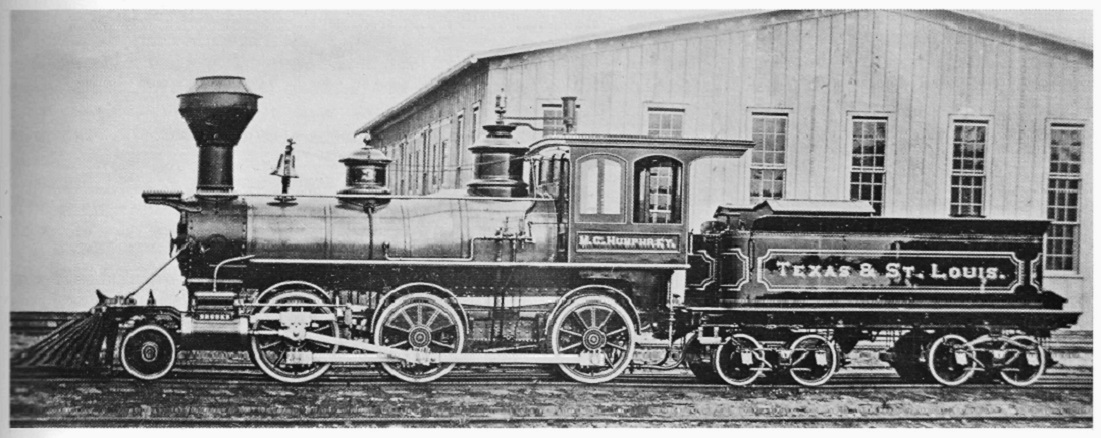 Numbers 3 and 4 were 2-6-0s similar in size and appearance to the locomotives built for the Utah & Northern and similar to the South Park's Brooks moguls in weight and traction. Note the familiar short wheel base tender trucks. One wonders if the T&StL considered them "cold water Brooks" 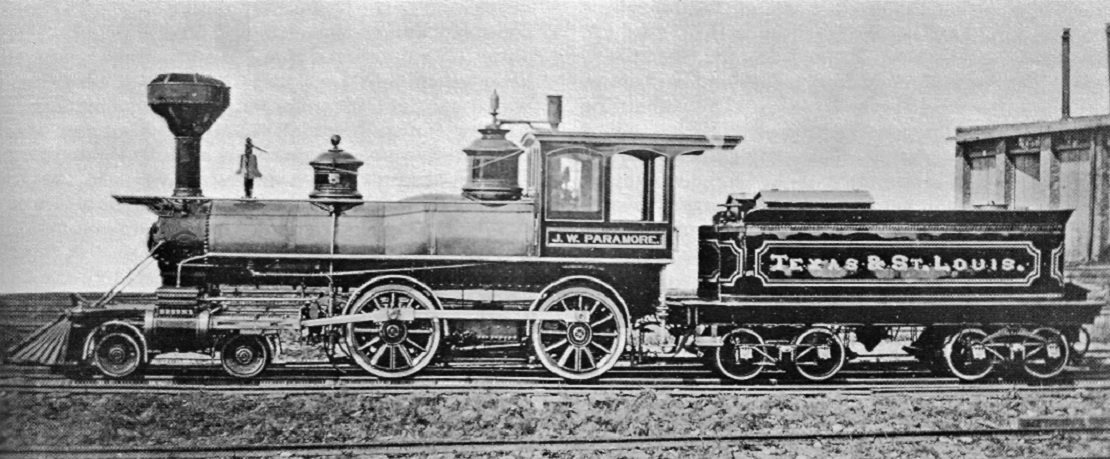 This is what a Brooks 4-4-0 would have looked like if one had been built for the South Park. Both photos from Gerald M Best collection, in Strapac, Cotton Belt Locomotives, page 33. Porter built locomotives 6 and 7 in mid-1879; no photos exist of 2-6-0 number 6, but 4-4-0 number 7 had its portrait taken at the builders factory:  Gerald M Best collection, in Strapac, Cotton Belt Locomotives, page 32. The next 67 locomotives built for the expanding T&StL were all built by Grant Locomotive works, between 1880 and 1884. Choosing a single locomotive builder may not have been for the virtues of standardization: Strapac speculates that many cash strapped, early narrow gauge railroads actually paid the builder in railroad company stock. Grant may have acquired enough T&StL stock to warrant a Grant representative a seat on the T&StL board of directors, insuring where new locomotive orders would go. Grant 2-6-0s, numbered 8 through 21, were still about the same size as the Brooks moguls. They were mostly used in construction service and proved too light for through train movements. The only photo of this class of engines that I found was this one, after sale to the Coeur d'Alene Railway & Navigation Co. in 1886, as their number 2, on July 4th, 1887: 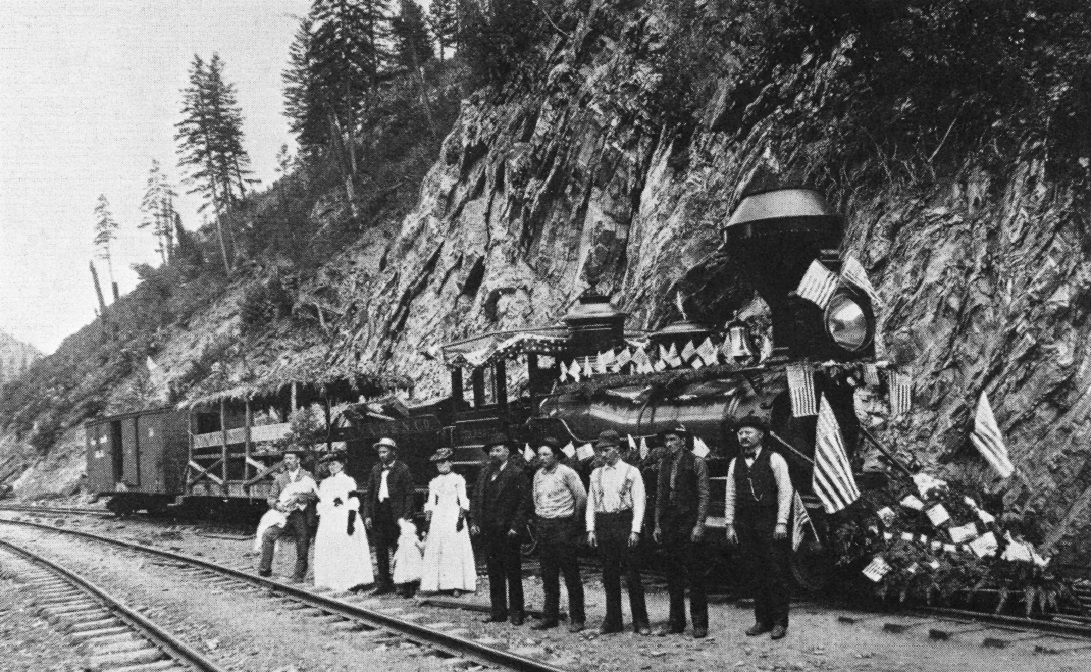 Gerald M Best collection, in Strapac, Cotton Belt Locomotives, page 34. Two of the T&StL light Grant moguls, numbers 18 and 29 were shipped from Pine Bluff to Washington State, to provide the first motive power for the Cd'AR&NCo, a Northern Pacific subsidiary, proving that at least some T&StL power ended up in the mountain west. When the D&RG couldn't find the funds to pay Grant for an order of class 60 2-8-0s, Grant in turn sold two of them to the T&StL where they were numbered 30 and 31. Strapac states they were popular in drag freight and helper service; they were the only 2-8-0s the T&StL ever owned. No photos exist, but drawings were produced as the two locomotives might have looked on the T&StL: 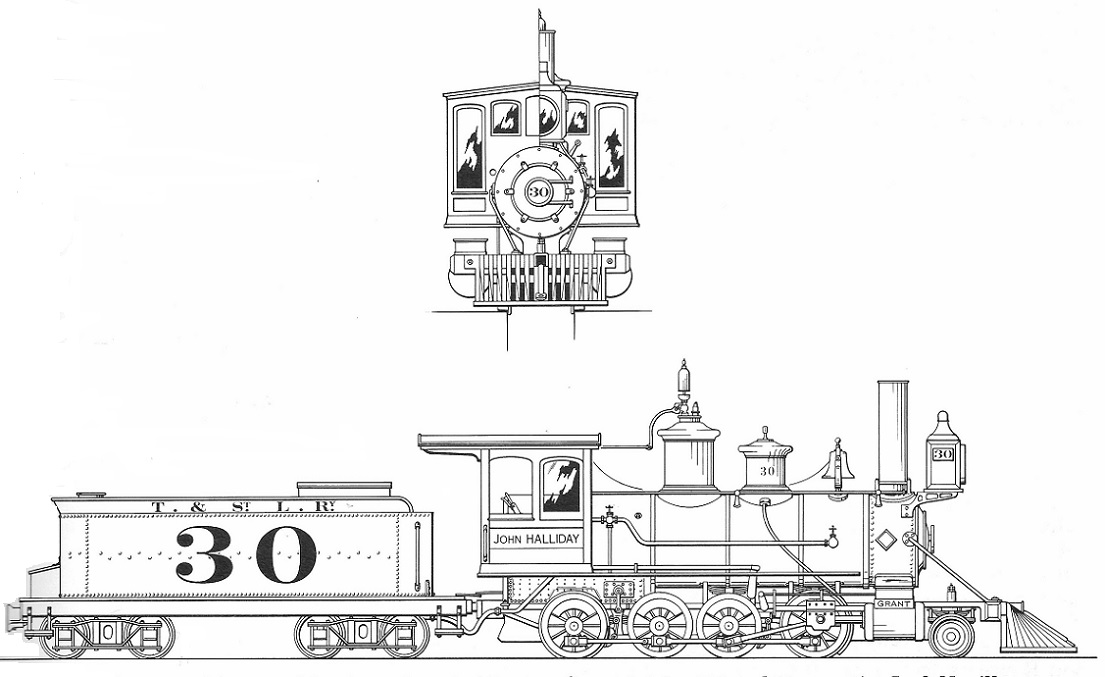 Drawing by Jack Neville, in Strapac, Cotton Belt Locomotives, page 35. I believe all T&StL narrow gauge engines were wood burners before 1886, so a diamond stack might have been more likely. Both locomotives were converted to standard gauge in 1887 and 1888, and later were sold to lumber companies out of state. They never made it to Colorado. Grant built a group of twenty 4-4-0s for the T&StL in 1882; they were similar to the D&RG's class 45 4-4-0s in specifications. These locomotives, numbered 32-51, were the mainline passenger power for the T&StL until standard gauging in 1886, including through Pullman service across the trunk line from Missouri to Texas:  Gerald M Best collection, in Strapac, Cotton Belt Locomotives, page 37. The photo below is a much better resolution image of the photo that I posted in the opening to this thread: 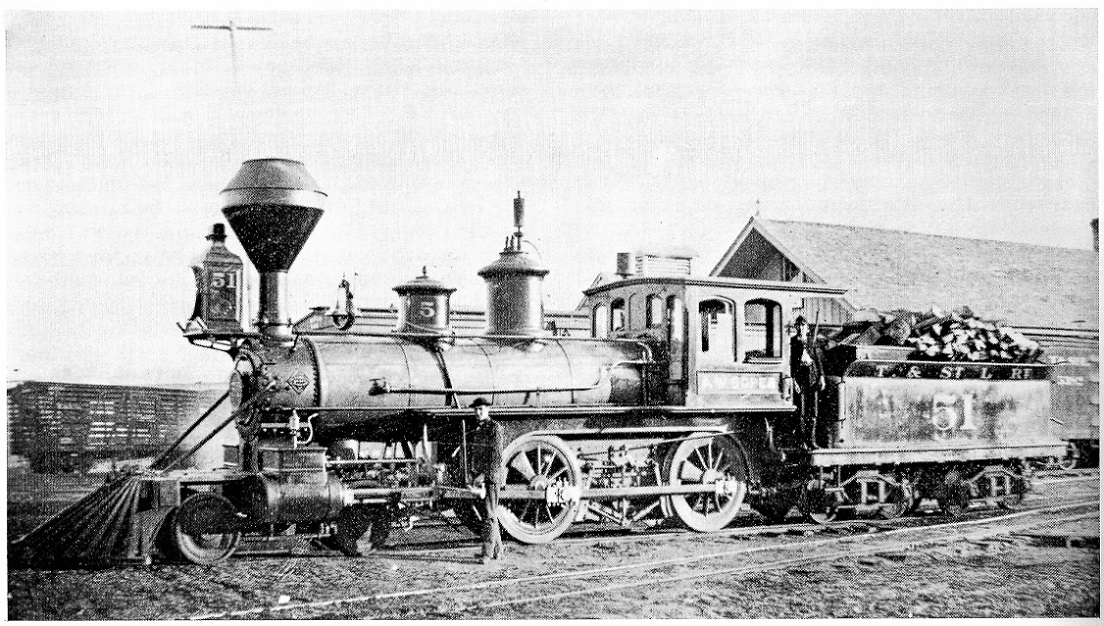 Cotton Belt Railroad/Haskell Collection, in Strapac, Cotton Belt Locomotives, page 36. This is the most fascinating photo of the T&StL that I've seen and would value Ron Rudnick's input on the freight cars in the background, the only one's I've found with T&StL markings. The stock car above number 51's pilot looks quite similar to the DSP&P 26-foot stock cars built by Litchfield, even to the location to letter board and the open slat ends. The end of the box car peeking out from behind the tender has T&StL reporting marks to the right of the obscured door, in initials; the road number is not really legible but is 4 digits, implying a vast freight car fleet. Any features on what little is visible to suggest a builder, Ron? It doesn't look like a Litchfield product of those years. With completion of the mainline, narrow gauge business boomed and heavier power was needed. Grant built 12 heavy 2-6-0s in late 1882, the 52-64 class:  Cotton Belt Railroad/Haskell Collection, in Abdill, Rails West, page 94. This locomotive is labeled as number 56 by Abdill. Note the flat car loaded with cotton bales on the siding near the pilot. 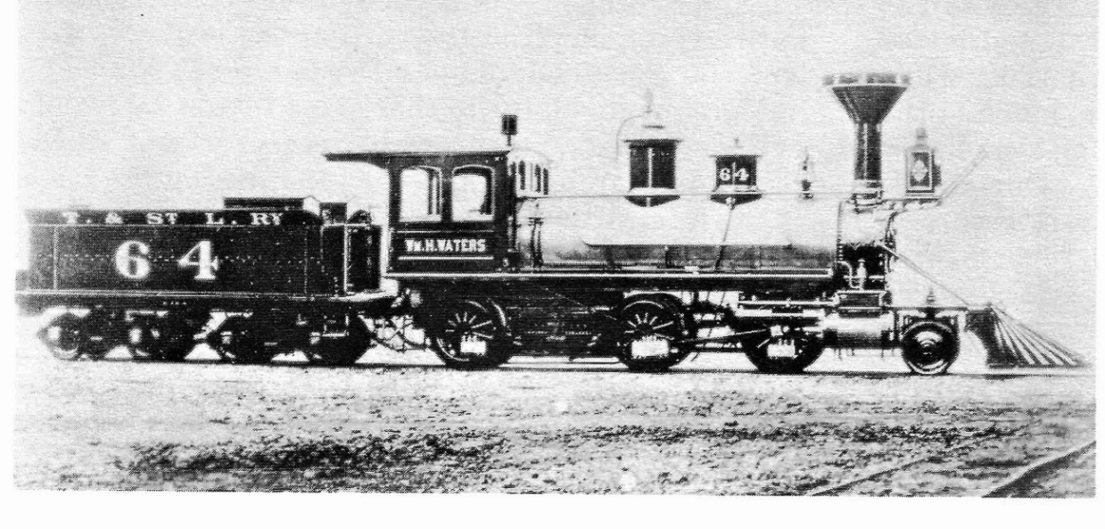 Collection of RH Carlson, in Strapac, Cotton Belt Locomotives, page 38. This is the builders photo of number 64. Grant built a final, slightly larger group of 2-6-0s in 1883, class 65-74, which were essential the same in size as the Grant ("class 60") 2-8-0s, built on six drivers instead of eight:  Cotton Belt Railroad, Vollrath collection, in Strapac, Cotton Belt Locomotives, page 38. This photo was taken on the Kansas & Gulf Short Line, after the T&StL was standard gauged in 1886, but before the K&GSL and the connecting HE&WT were standard gauged in 1895. During that time, the K&GSL leased a number of T&StL narrow gauge locomotives. Number 67 is now a coal burner with shotgun stack. That sure is a nifty narrow gauge caboose trailing 67. I can't tell if it is lettered for the T&StL or the K&GSL, but I suspect the latter. The final group of motive power for the T&StL were a group of heavy 2-6-0s built by Rhode Island in the spring of 1884, the 10 engines of class 75-84, the last narrow gauge engines built for the T&StL: 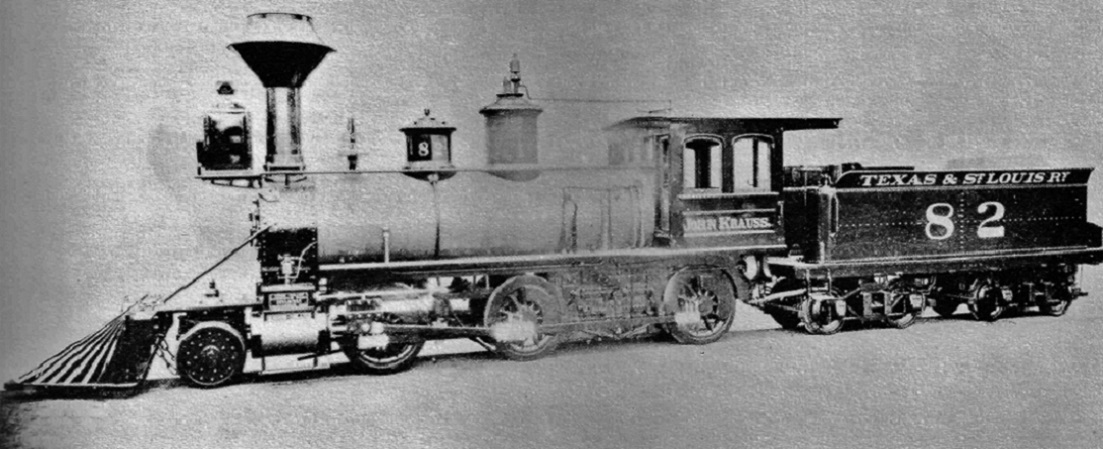 Cotton Belt Railroad/Haskell Collection, in Strapac, Cotton Belt Locomotives, page 39. These locomotives were near identical in weight and tractive effort as the Rhode Island 2-8-0s built for the Utah and Northern, later C&S numbers 57-62. 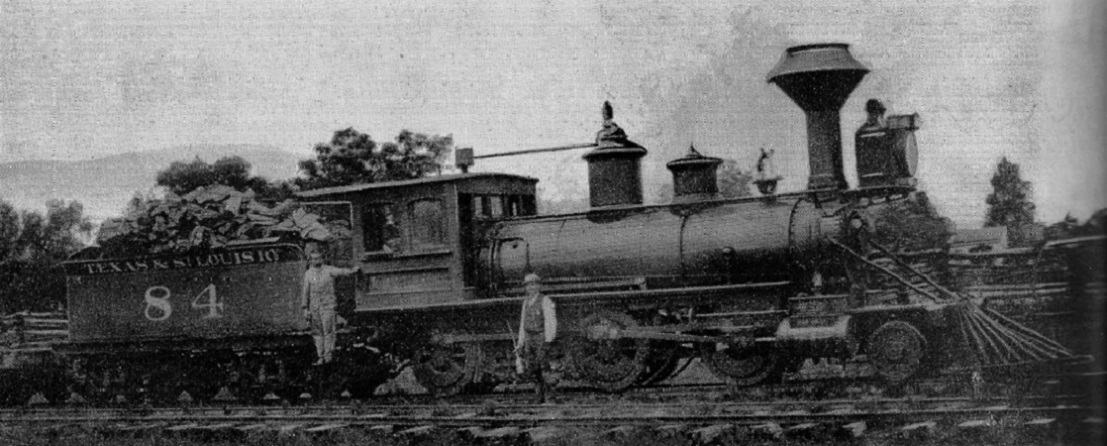 Cotton Belt Railroad/Haskell Collection, in Abdill, Rails West, page 94. This is the original print of the doctored image that I posted above at the beginning of this thread. Note the stock pens behind the locomotive and the flat car with cotton bales trailing the tender. By 1886, the narrow gauge trunk line of the T&StL was so successful that it was standard gauged, to better handle the growing business on the route. I wondered why none of the then surplus T&StL motive power, some of it heavy and nearly new, never migrated to Colorado or the mountain west. As it turns out, the newer narrow gauge motive power wasn't really surplus: Four engines were leased and used by the K&GSL (T&StL 34, 39, 67 and 74). More importantly, at least 28 of the newest and heaviest locomotives were standard gauged between 1887 and 1890: 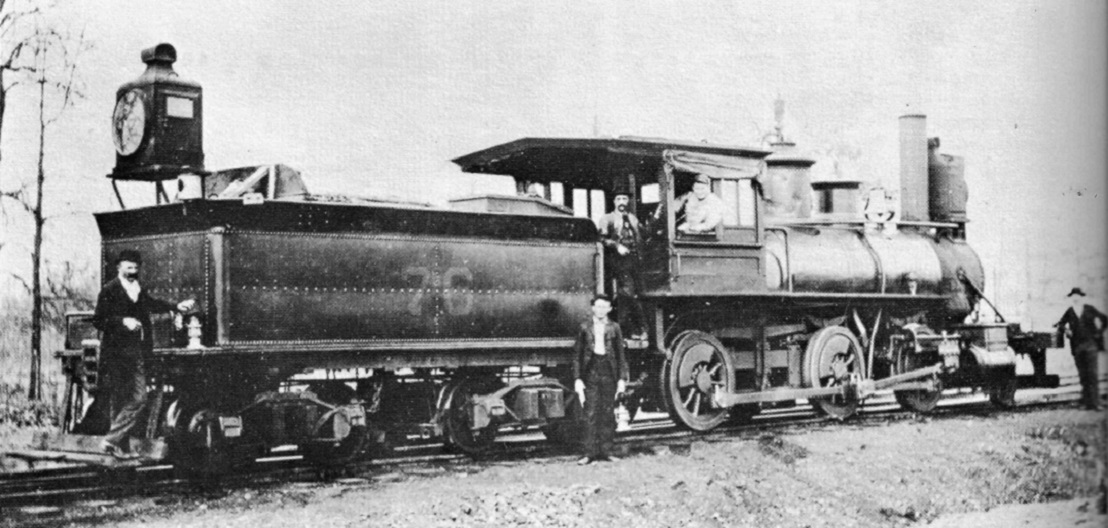 Cotton Belt Railroad/Haskell Collection, in Strapac, Cotton Belt Locomotives, page 40. Rhode Island number 76 is now a coal burner and has been standard gauged. Same drivers, just new, longer axles. Eames vacuum brakes were the standard for all T&StL engines up until 1898. In many of the above photos, notice the Eames cylinder under the rear of the cab, mounted to the cab brace. I will add some photos and information on the Kansas & Gulf Short Line later . . .
Jim Courtney
Poulsbo, WA |
«
Return to C&Sng Discussion Forum
|
1 view|%1 views
| Free forum by Nabble | Edit this page |

